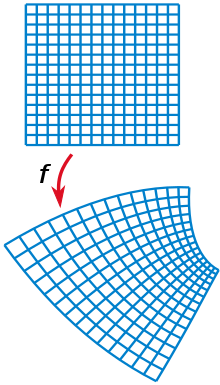Topology Via Nearness
Me riffing off of this superb mathoverflow answer.
Disclaimer: this really is me riffing. Some of the content here might be plain wrong or mistaken.
Say we have a set , which we want to endow with a topological structure. The usual way of doing this is to pair it with a topology, which is a collection of subsets of satisfying some conditions; members of the topology are called “open sets”.
Personally I never really understood this construction, nor its associated definitions for continuity, closedness, etc. Here’s an alternative set of constructions I like better.
Grazing
So we have . We want to somehow endow it with topological stuff like notions of openness, closeness, continuity, and the like.
Our starting point is grazing. We ask that be given a grazing relation which relates elements of with subsets of . We think of as telling us that is either in or is arbitrarily/infinitely close to (it ‘grazes’ ).
For the set , for instance, we may choose that
that is, grazes iff the set contains elements which are arbitrarily-close to . Keep this example in mind: we’ll continue to use paired with this grazing relation as a source of intuition.
Expressely, the requirements we place on the grazing relation are as follows:
| 1 | Empty set is grazed by nothing | |
|---|---|---|
| 2 | If then | Grazing is weaker than membership |
| 3 | If then either or | |
| 4 | If and then | Grazing is ‘transitive’ |
Closedness
Given a subset , the closure is the union of taken together with all its grazing poins. That is, taking a closure simply expands a set to include everything infinitely close to it.
A set is called closed if it is the closure of some other set. Equivalently, is closed iff
In one can think of taking a closure as adding the ‘outline’ of to . A set is closed if it already contains its outline. By outline I mean what you would expect for things like discs and polygons; for a single point I mean the singleton of that point, and for more complex things let’s not worry about it. (The ‘outline’ is reified as the notion of boundary, which we will define later.)
Openness
A set is open iff its complement is closed.
Okay, so what does this mean? Given a set , we have that is open iff . The closure contains plus all its infinitely-close points. Hence this says that is open iff it contains none of the points infinitely-close to .
Loosely I think of this as a certain kind of statement of distance: no matter how I traverse through , I will always be “far away” from the rest of the space insofar as I will not be infinitely close to it. (I will be “finitely far” from it)
In a set is open if and only if it is expressible as a union of finite intersections of -balls. I think of this as all sets that exclude their outline. In such an open set we can always traverse towards the boundary but we will never break through it.
(Another phrasing I saw: a set is open if one cannot reach any of its points without entering the set)
Boundaries
For a set the interior of is the minimal subset of whose closure is equal to the closure of . We can think of this as removing from only those points which are infinitely close to the rest of , but not those which are “actually in” the rest of .
In we can think of taking the interior as erasing the outline of .
The boundary of is the set : this is kinda all the points which are infitely close to but none of the points which are actually in .
Honestly I think prehaps that boundaries are maybe the real point and that one could use as the generating notion instead of . Mayhaps! We continue.
A function is continuous if it preserves grazing; that is, if
In other words, if is ‘close to’ then respects this: must respect ‘closeness’.
Already to me this is better than any of the traditional definitions for continuity. But we’re not done yet!
It’s common to describe topologically-continuous functions as “functions which cannot tear or glue”. I try to justify this now. Note that since a continuous function respects then it also respects boundaries;
(HUGE IMPORTANT NOTE: I’m not positive that the biconditional in the above is valid, but it is crucial for parts of the following argument! ... ah, figured it out — a continuous function gives ‘no tearing’; a homeomorphism (continuous with continuous two-sided inverse) also gives ‘no gluing’)
This will be enough: we now exhibit functions which serve to exemplify both why “tearing” violates boundary-preservations as well as why “gluing” does. Our example lives in .
Continuity (pt II)
Above I tried to give a justification that continuous functions “cannot tear nor glue” by observing that in principle any instance of tearing or gluing constitutes a failure to respect boundaries and thus to be continuous. In addition here I want to give a viewpoint which attempts to consider the entire space at once.
Note that every Jordan curve (≈ continuous non-self-intersecting loop) in splits the plane into two regions sharing a boundary. Continuous functions must respect this boundary, as well as the boundaries induced by every other Jordan curve, all at the same time. We can imagine covering any portion of the space with a ‘net’ of Jordan curves; a continuous map must preserve all portions of the net at once.

Via limit points?
Kinda prefer this... seems cleaner conceptually
Border:
Continuity: grazing-preserving = border-preserving
Homeomorphism: bijective dually-border-preserving = no tearing, gluing